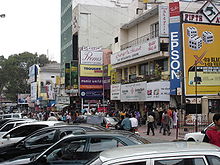Bangalore
![]()
This article is about the city of Bengaluru, formerly Bangalore. For the weapon, see Bangalore (bomb).
Bengaluru (official name since 2014; Kannada: ಬೆಂಗಳೂರು Beṅgaḷūru [![]()
![]() ˈbeŋɡəɭuːru]), English Bangalore [
ˈbeŋɡəɭuːru]), English Bangalore [![]()
![]() ˈbæŋɡəlɔːr] is the capital of the Indian state of Karnataka in the southwest of the subcontinent.
ˈbæŋɡəlɔːr] is the capital of the Indian state of Karnataka in the southwest of the subcontinent.
With a population of 11.4 million (2018), it is the third largest city in India after Mumbai and Delhi. Bengaluru is also the administrative headquarters of the districts of Bengaluru Urban and Bengaluru Rural.
Bengaluru is a centre of India's civil and military aerospace industry and research. More recently, it has also become one of the most important IT centers in the country. Because of its numerous parks, Bengaluru is often referred to as the "Garden City".
Geography and climate
Bengaluru is located in the Deccan Tableland, in the southern part of the Indian subcontinent, at an altitude of about 900 meters. As a result, mild temperatures prevail despite the tropical location at about 13 degrees north latitude - in winter the temperature drops to about 15 degrees Celsius at night, in summer it can rise to 37 degrees Celsius during the day. The monsoon rains last from May to October.
| Bengaluru | ||||||||||||||||||||||||||||||||||||||||||||||||
| Climate diagram | ||||||||||||||||||||||||||||||||||||||||||||||||
| ||||||||||||||||||||||||||||||||||||||||||||||||
| Monthly average temperatures and precipitation for Bengaluru
Source: WMO; wetterkontor.de | ||||||||||||||||||||||||||||||||||||||||||||||||||||||||||||||||||||||||||||||||||||||||||||||||||||||||||||||||||||||||||||||||||||||||||||||||||||||||||||||||||||||||||||||||||||||||||||||||||||||||||||||||||||||||||||||||||||||||||||||||||||||||||||
The largest body of water is Lake Bellandur.
History
Bengaluru was probably founded in 1537 by Kempe Gowda I (1510 to 1570). Kempe Gowda is said to have chosen the name Bengaluru for this new city because his mother and wife came from a settlement of that name that still exists today as Halebengaluru (Old Bengaluru) near Bengaluru. According to another version, an old woman in the 10th century gave cooked beans to King Veeraballa to eat when he was lost in the forest. Out of gratitude, he is said to have thereafter named the place Benda Kaluru, the "City of Boiled Beans".
The British under Charles Cornwallis captured the city in 1799 in a battle with Tipu Sultan and anglicized the name to "Bangalore".
In 1898, Bangalore was hit by a plague epidemic that claimed a large number of victims. As a result, sanitation and health services were modernized and regulations for sanitation were enacted in the construction of new houses. In 1900, the Victoria Hospital was opened.
After 1900, Bangalore expanded rapidly. By 1950, the districts of Basavanagudi, Malleshwaram, Kalasipalyam, Gandhinagar and Jayanagar had come into being.
Until 1949 Bangalore was an important garrison town of the British, of which street names like Brigade Road or Residency Road still bear witness today.
In 2006, the Karnataka state government decided to change the anglicized spelling of "Bangalore" to "Bengaluru" according to the Kannada form. The Government of India approved this decision in 2014.

Shopping street in Bengaluru
Search within the encyclopedia